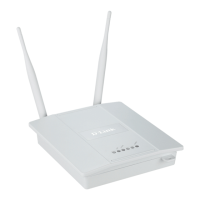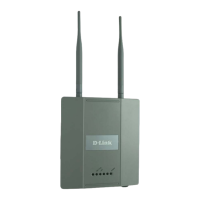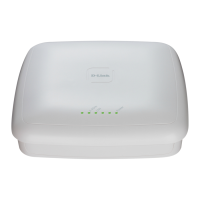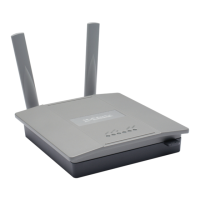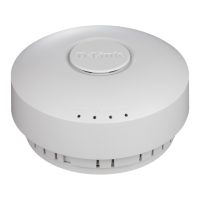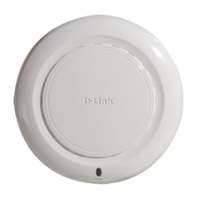
Do you have a question about the D-Link DWL-3260AP - AirPremier - Wireless Access Point and is the answer not in the manual?
| Device Type | Wireless Access Point |
|---|---|
| Frequency Band | 2.4 GHz, 5 GHz |
| Data Rate | 54 Mbps |
| Power over Ethernet | Yes |
| Wireless Standard | IEEE 802.11g |
| Data Link Protocol | Ethernet |
| Antenna Type | External |
| Ports | 1 x network - Ethernet 10Base-T/100Base-TX - RJ-45 |
| Interface | Ethernet |
| Security | WEP, WPA, WPA2 |
| Authentication Method | RADIUS |
| Compliant Standards | IEEE 802.11g |
| Features | VLAN support |
| Operating Temperature | 32 - 104 °F (0 - 40 °C) |
| Storage Temperature | -4 - 140 °F (-20 - 60 °C) |
| Humidity | 10 - 90% (operating), 5 - 95% (storage) |
| Weight | 1.54 lbs (0.7 kg) |
Lists the physical components included in the product package.
Specifies the necessary hardware and software to operate the device.
Details the wireless data rates and compliance with IEEE standards.
Explains the benefits and functionality of PoE for device installation.
Discusses discreet installation options and robust wireless security technologies.
Describes the Wireless Distribution System modes for network connectivity.
Describes the device's suitability for enterprise use and its physical design.
Outlines the three distinct operating modes: Access Point, WDS with AP, and WDS.
Details PoE installation, high-speed wireless, backward compatibility, and WPA security.
Explains management software, SNMP support, OFDM technology, and web interface capabilities.
Defines WLAN and its increasing use in various environments.
Explains the various benefits and uses of WLAN technology for users.
Summarizes the core advantages of WLANs like mobility, cost, expansion, and scalability.
Explains the device's adherence to IEEE 802.11b and 802.11g standards.
Provides guidelines for optimizing wireless signal range by considering walls and interference.
Describes the function of the device as a standard wireless access point.
Explains operating as a WDS bridge while also functioning as an access point.
Details the WDS mode for wirelessly connecting multiple networks.
Outlines prerequisites and initial steps for setting up the device.
Guides users on connecting the AP to the router, PoE base unit, and computers.
Provides a step-by-step guide for connecting the device using Power over Ethernet.
Details how to access the device's web-based configuration interface.
Explains the default username and password for logging into the system.
Shows system details like firmware version and IP address after login.
Instructs users on how to save configuration changes made within the interface.
Selects the wireless band (802.11g) and operating mode.
Configures the network name (SSID) and controls SSID broadcast visibility.
Sets the wireless channel and authentication method for the network.
Configures WEP encryption keys, type, and size for network security.
Details options for automatic channel selection and various authentication protocols.
Manages encryption settings and key input for network security.
Configures encryption cipher and group key update frequency for WPA-Enterprise.
Sets up primary and secondary RADIUS servers for enterprise authentication.
Configures primary and secondary accounting servers for network activity logging.
Sets encryption cipher and group key update interval for WPA-Personal.
Allows setting a passphrase for WPA-Personal authentication.
Specifies MAC addresses of remote APs for WDS bridging.
Enables scanning for networks and configuring authentication for WDS connections.
Configures the wireless channel and auto-scan feature for WDS.
Manages remote AP MAC addresses and performs WDS site surveys.
Details available authentication methods for WDS connections.
Manages remote AP MAC addresses and performs WDS site surveys.
Configures the wireless channel and auto-scan feature for WDS.
Details available authentication methods for WDS connections.
Configures the wireless channel and auto-scan feature for WDS.
Manages remote AP MAC addresses and performs WDS site surveys.
Details available authentication methods for WDS connections.
Describes the basic function of the device as a wireless access point.
Explains the combined WDS bridge and AP functionality.
Details the WDS mode for connecting networks wirelessly.
Configures IP addressing for the local area network interface.
Sets the subnet mask and default gateway for network communication.
Selects the wireless band and displays the operating frequency.
Configures the wireless channel and base data transfer rates.
Adjusts beacon intervals and DTIM for network synchronization and traffic indication.
Manages packet fragmentation and RTS thresholds for transmission efficiency.
Controls transmit power and configures Super G performance enhancements.
Configures WMM, preamble, B/G mode, and data rate control for wireless performance.
Enables load balancing to distribute traffic across multiple access points.
Sets the maximum number of users allowed to connect to an AP.
Manages link integrity to detect and react to Ethernet connection loss.
Activates multiple SSIDs and VLAN state for network segmentation.
Configures wireless band, index, and Service Set Identifier for SSIDs.
Sets security levels and VLAN IDs for multi-SSID networks.
Configures WMM, key type, and key size for multi-SSID security.
Allows input of encryption keys for multi-SSID security configurations.
Sets cipher type and group key update interval for WPA/WPA2.
Enters the passphrase for WPA/WPA2 personal security.
Selects the BSS type and wireless band for AP detection.
Defines security types to consider during rogue AP detection.
Specifies security types for rogue AP detection criteria.
Displays detected rogue APs and lists APs allowed on the network.
Enables the DHCP server and specifies the starting IP address for dynamic assignments.
Configures the size of the IP address pool and the subnet mask.
Sets the default gateway, WINS server, and DNS server addresses.
Configures the domain name and lease duration for DHCP clients.
Enables or disables the DHCP dynamic pool settings.
Controls DHCP server and assigns static IP addresses to specific devices.
Enters the MAC address and subnet mask for static IP assignments.
Sets gateway, WINS, and DNS for static IP assignments.
Configures domain name and enables/disables static pool settings.
Displays active dynamic IP assignments, MAC addresses, and lease times.
Shows IP address pools assigned statically to devices.
Details MAC addresses and assigned static IP addresses for devices.
Configures the wireless band and enables/disables MAC address filtering.
Manages the list of MAC addresses for access control (Accept/Reject).
Controls communication between wireless clients connected to the same AP.
Manages data flow between Ethernet devices and wireless clients.
Displays firmware version, MAC addresses, and Ethernet interface settings.
Shows current wireless settings, AP status, and resource utilization.
Displays information about currently connected wireless clients.
Shows statistics for transmitted Ethernet frames and bytes.
Displays statistics for received Ethernet frames and bytes.
Reports on WLAN throughput, transmitted frames, and transmission errors.
Details received WLAN frames, FCS errors, and WEP errors.
Displays a summary and detailed entries of system and network events.
Configures logging server, IP address, and types of events to log.
Sets up SMTP for sending log notifications via email.
Restricts administrator access based on IP address or VLAN ID.
Manages user login credentials and console access protocols.
Configures SNMP settings and external LED indicator status.
Enables or disables console and SNMP functions.
Sets public and private SNMP community strings for network management.
Controls the status and behavior of external LED indicators.
Guides users on updating the device firmware from a local file.
Details the process for uploading SSL certification files to the device.
Applies a saved configuration file to the device.
Saves the current device configuration to a local file.
Selects a configuration file and initiates the loading process for device settings.
Configures NTP server and time zone for accurate time synchronization.
Allows manual time setting or copying from the host computer, including DST.
Restarts the device to apply changes or reboot.
Resets the device to its original factory default configuration.
Explains parameters for optimizing wireless network performance.
Details settings like fragment length and RTS interval for transmission efficiency.
Lists supported wireless and network standards and their data rates.
Specifies the operating frequency range and antenna characteristics.
Details the radio and modulation technologies used by the device.
Lists transmit power output and receiver sensitivity levels.
Lists supported operation modes and security protocols.
Details VLAN tagging capabilities and WMM (Wi-Fi Multimedia) QoS.
Outlines the interfaces available for managing the device.
Provides physical dimensions, weight, power, environmental ratings, and certifications.



